Anti-Histone H3 (phospho S10) antibody ab47297 Product datasheet 12 Abreviews 5 Images
advertisement
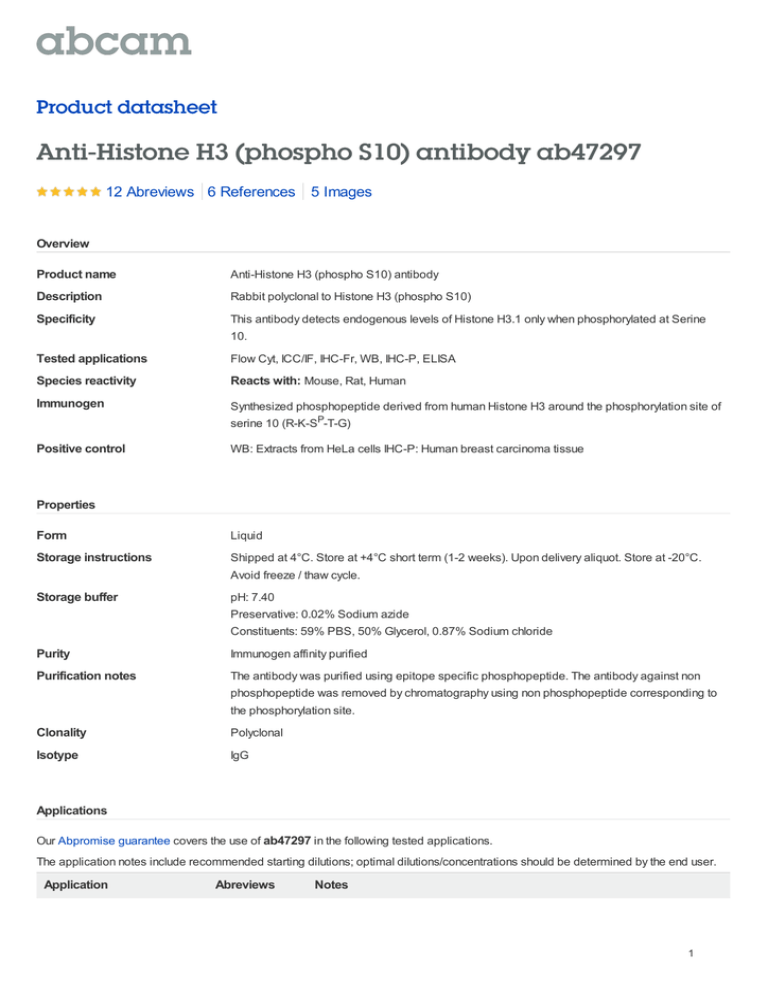
Product datasheet Anti-Histone H3 (phospho S10) antibody ab47297 12 Abreviews 6 References 5 Images Overview Product name Anti-Histone H3 (phospho S10) antibody Description Rabbit polyclonal to Histone H3 (phospho S10) Specificity This antibody detects endogenous levels of Histone H3.1 only when phosphorylated at Serine 10. Tested applications Flow Cyt, ICC/IF, IHC-Fr, WB, IHC-P, ELISA Species reactivity Reacts with: Mouse, Rat, Human Immunogen Synthesized phosphopeptide derived from human Histone H3 around the phosphorylation site of serine 10 (R-K-SP-T-G) Positive control WB: Extracts from HeLa cells IHC-P: Human breast carcinoma tissue Properties Form Liquid Storage instructions Shipped at 4°C. Store at +4°C short term (1-2 weeks). Upon delivery aliquot. Store at -20°C. Avoid freeze / thaw cycle. Storage buffer pH: 7.40 Preservative: 0.02% Sodium azide Constituents: 59% PBS, 50% Glycerol, 0.87% Sodium chloride Purity Immunogen affinity purified Purification notes The antibody was purified using epitope specific phosphopeptide. The antibody against non phosphopeptide was removed by chromatography using non phosphopeptide corresponding to the phosphorylation site. Clonality Polyclonal Isotype IgG Applications Our Abpromise guarantee covers the use of ab47297 in the following tested applications. The application notes include recommended starting dilutions; optimal dilutions/concentrations should be determined by the end user. Application Abreviews Notes 1 Application Flow Cyt Abreviews Notes 1/500. ab171870-Rabbit polyclonal IgG, is suitable for use as an isotype control with this antibody. ICC/IF 1/1000. IHC-Fr 1/2000. See Abreview. WB 1/500 - 1/1000. Detects a band of approximately 15 kDa (predicted molecular weight: 15 kDa). IHC-P Use at an assay dependent concentration. ELISA 1/10000. Target Function Variant histone H3 which replaces conventional H3 in a wide range of nucleosomes in active genes. Constitutes the predominant form of histone H3 in non-dividing cells and is incorporated into chromatin independently of DNA synthesis. Deposited at sites of nucleosomal displacement throughout transcribed genes, suggesting that it represents an epigenetic imprint of transcriptionally active chromatin. Nucleosomes wrap and compact DNA into chromatin, limiting DNA accessibility to the cellular machineries which require DNA as a template. Histones thereby play a central role in transcription regulation, DNA repair, DNA replication and chromosomal stability. DNA accessibility is regulated via a complex set of post-translational modifications of histones, also called histone code, and nucleosome remodeling. Sequence similarities Belongs to the histone H3 family. Developmental stage Expressed throughout the cell cycle independently of DNA synthesis. Post-translational modifications Acetylation is generally linked to gene activation. Acetylation on Lys-10 (H3K9ac) impairs methylation at Arg-9 (H3R8me2s). Acetylation on Lys-19 (H3K18ac) and Lys-24 (H3K24ac) favors methylation at Arg-18 (H3R17me). Citrullination at Arg-9 (H3R8ci) and/or Arg-18 (H3R17ci) by PADI4 impairs methylation and represses transcription. Asymmetric dimethylation at Arg-18 (H3R17me2a) by CARM1 is linked to gene activation. Symmetric dimethylation at Arg-9 (H3R8me2s) by PRMT5 is linked to gene repression. Asymmetric dimethylation at Arg-3 (H3R2me2a) by PRMT6 is linked to gene repression and is mutually exclusive with H3 Lys-5 methylation (H3K4me2 and H3K4me3). H3R2me2a is present at the 3' of genes regardless of their transcription state and is enriched on inactive promoters, while it is absent on active promoters. Specifically enriched in modifications associated with active chromatin such as methylation at Lys-5 (H3K4me), Lys-37 and Lys-80. Methylation at Lys-5 (H3K4me) facilitates subsequent acetylation of H3 and H4. Methylation at Lys-80 (H3K79me) is associated with DNA doublestrand break (DSB) responses and is a specific target for TP53BP1. Methylation at Lys-10 (H3K9me) and Lys-28 (H3K27me), which are linked to gene repression, are underrepresented. Methylation at Lys-10 (H3K9me) is a specific target for HP1 proteins (CBX1, CBX3 and CBX5) and prevents subsequent phosphorylation at Ser-11 (H3S10ph) and acetylation of H3 and H4. Methylation at Lys-5 (H3K4me) and Lys-80 (H3K79me) require preliminary monoubiquitination of H2B at 'Lys-120'. Methylation at Lys-10 (H3K9me) and Lys-28 (H3K27me) are enriched in inactive X chromosome chromatin. Phosphorylated at Thr-4 (H3T3ph) by GSG2/haspin during prophase and dephosphorylated during anaphase. Phosphorylation at Ser-11 (H3S10ph) by AURKB is crucial for chromosome condensation and cell-cycle progression during mitosis and meiosis. In addition phosphorylation at Ser-11 (H3S10ph) by RPS6KA4 and RPS6KA5 is important during interphase because it enables the transcription of genes following external stimulation, like mitogens, stress, growth 2 factors or UV irradiation and result in the activation of genes, such as c-fos and c-jun. Phosphorylation at Ser-11 (H3S10ph), which is linked to gene activation, prevents methylation at Lys-10 (H3K9me) but facilitates acetylation of H3 and H4. Phosphorylation at Ser-11 (H3S10ph) by AURKB mediates the dissociation of HP1 proteins (CBX1, CBX3 and CBX5) from heterochromatin. Phosphorylation at Ser-11 (H3S10ph) is also an essential regulatory mechanism for neoplastic cell transformation. Phosphorylated at Ser-29 (H3S28ph) by MLTK isoform 1, RPS6KA5 or AURKB during mitosis or upon ultraviolet B irradiation. Phosphorylation at Thr-7 (H3T6ph) by PRKCBB is a specific tag for epigenetic transcriptional activation that prevents demethylation of Lys-5 (H3K4me) by LSD1/KDM1A. At centromeres, specifically phosphorylated at Thr-12 (H3T11ph) from prophase to early anaphase, by DAPK3 and PKN1. Phosphorylation at Thr-12 (H3T11ph) by PKN1 is a specific tag for epigenetic transcriptional activation that promotes demethylation of Lys-10 (H3K9me) by KDM4C/JMJD2C. Phosphorylation at Tyr-42 (H3Y41ph) by JAK2 promotes exclusion of CBX5 (HP1 alpha) from chromatin. Phosphorylation on Ser-32 (H3S31ph) is specific to regions bordering centromeres in metaphase chromosomes. Ubiquitinated. Monoubiquitinated by RAG1 in lymphoid cells, monoubiquitination is required for V(D)J recombination. Cellular localization Nucleus. Chromosome. Anti-Histone H3 (phospho S10) antibody images ab47297 detecting Histone H3 (phosphoS10) in assynchronous HeLa cells, in conjunction with a goat anti-rabbit secondary antibody conjugated to Cy3 (ab6939). Cells were also counterstained with DAPI in order to highlight the nucleus. For further details, please refer to abreview. Immunocytochemistry/ Immunofluorescence Histone H3 (phospho S10) antibody (ab47297) This image is courtesy of an Abreview submitted by Dr Kirk McManus 3 All lanes : Anti-Histone H3 (phospho S10) antibody (ab47297) Lane 1 : EGF + Calyculin treated HeLa cells + phospho-peptide. Lane 2 : EGF + Calyculin treated HeLa cells. No phosphopeptide. Lysates/proteins at 30 µg per lane. Western blot - Histone H3 (phospho S10) antibody (ab47297) Predicted band size : 15 kDa ab47297 staining human breast carcinoma by IHC-P (left hand panel). The right hand panel shows staining in the presence of immunizing phosphopeptide. Ab47297 staining human breast carcinoma by IHC-P (left hand panel). The right hand Immunohistochemistry (Paraffin-embedded sections) - Histone H3 (phospho S10) antibody panel shows staining in the presence of immunizing phosphopeptide. (ab47297) ab47297 staining Histone H3 (phospho S10) in embryonic mouse brain by IHC-Fr (Paraformaldehyde-fixed Frozen sections). Tissue was fixed with paraformaldehyde, permeabilized with 0.1% TX-100 and blocked with 10% serum for 1 hour at 25°C. Samples were incubated with primary antibody 1/2000 (10%NGS in PBS + 0.1% TX10) for 16 hours at 25°C. A goat anti-rabbit Alexa Fluor® 488 (ab150077), dilution 1/400, was used as secondary antibody. The image shows Immunohistochemistry (Frozen sections) - ab47297 staining (green) in the CNS Histone H3 (phospho S10) antibody (ab47297) ventricular zone; there was no background This image is courtesy of an Abreview submitted by Dr Ben Deverman staining with ab47297. 4 ab47297 (Rabbit polyclonal to Histone H3 (phospho S10) ) identifying a sub-population of HCT116 cells with elevated FL1-H (PhosS10 labeling). For further experimental details please refer to abreview. Flow Cytometry - Histone H3 (phospho S10) antibody (ab47297) This image is courtesy of an Abreview submitted by Dr Kirk McManus Please note: All products are "FOR RESEARCH USE ONLY AND ARE NOT INTENDED FOR DIAGNOSTIC OR THERAPEUTIC USE" Our Abpromise to you: Quality guaranteed and expert technical support Replacement or refund for products not performing as stated on the datasheet Valid for 12 months from date of delivery Response to your inquiry within 24 hours We provide support in Chinese, English, French, German, Japanese and Spanish Extensive multi-media technical resources to help you We investigate all quality concerns to ensure our products perform to the highest standards If the product does not perform as described on this datasheet, we will offer a refund or replacement. For full details of the Abpromise, please visit http://www.abcam.com/abpromise or contact our technical team. Terms and conditions Guarantee only valid for products bought direct from Abcam or one of our authorized distributors 5
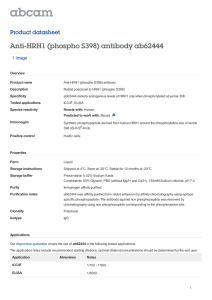



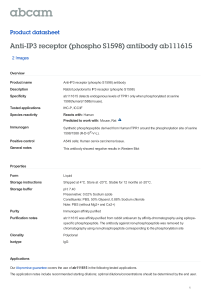
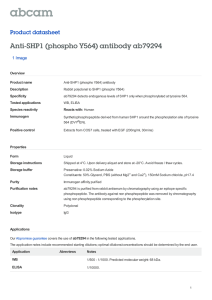
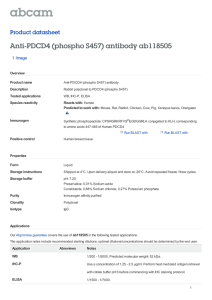

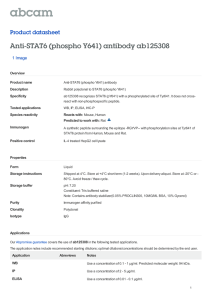
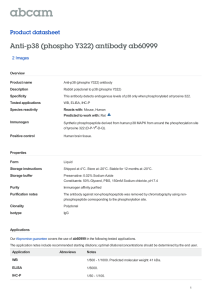
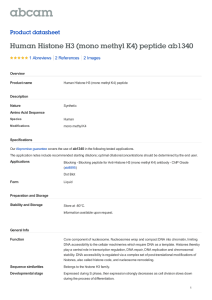
![Anti-Histone H3 (phospho S10 + T11) antibody [E173]](http://s2.studylib.net/store/data/013129080_1-e5bf94aa2620e2bb1fbc13c6d185dfac-300x300.png)